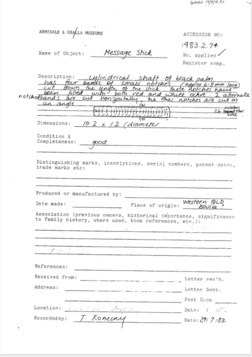UNEMA1983_2_74
Title: A message stick of uncertain provenance in the University of New England Antiquities Museum
Description: UNEMA (University of New England Museum of Antiquities) Catalogue data: "Provenance: Central Australia Description: "Two small message sticks with carved decoration" Based on the above 2 points this usually means that nothing else was known about the sticks when the Folk Museum provided them to UNEMA - any info the Folk Museum could provide would have been pasted into the hard file Dated as "Recent" which usually means mid-20th century (ie. not of any antiquity) dimensions: L: 100mm, Diam: 15mm Status: They are a permanent Loan from the Armidale Folk Museum." Armidale Folk Museum description: "Description: cylindrical shaft of black palm has four bands of small notches (approx 6-8mm long) cut down the length of the stick. These notches have been filled with both red and white ochre. 2 alternate notched bands are cut horizontally, the other notches are cut on an angle. 26 notches other side. Dimensions: 10.2 x 1.2 (diameter) Condition and completeness: good Place of origin: Western Qld, Boulia? Recorded by: T. Konecny Date: 29/7/83 "
Item type: message stick in a collection
Dimension 1: 102mm Dimension 2: 12mm
Institution/Holder file: University of New England Museum of Antiquities object identifier: 1983.2.74 (Armidale Folk Museum accession number)
Media copyright: University of New England Museum of Antiquities
Notes: NR wrote to PK on 7 September 2020: "The visual appearance of the UNE message sticks looks very much like the banksia dentate central stem – but that’s a general impression – I can’t claim to be familiar enough with pan-Australian timbers to provide you with the kind of metadata that might assist with provenance." PK replied on 7 September 2020: "The Museum of Antiquities has since retrieved provenance information from a record which simply says: "Central Australia". There is not a particularly strong tradition of message stick use in Central Australia, and if the wood does turn out to be Banksia dentata it would contradict this provenance since this species only grows in the tropics, according to the Atlas of Living Australia."
Media Files:
Data Entry: Piers Kelly

